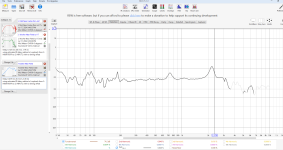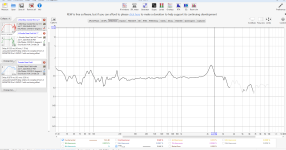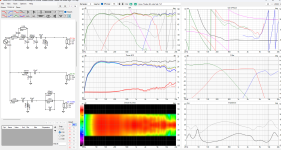I was trying to address the rising tweeter response that was to be found in an alternative design. A downward-sloping in-room response, which is a desirable target, is already an inherent byproduct of the three-way loudspeaker design. I'm unsure how much, if anything, a smoother in-room response would benefit the sound quality if the on-axis response was deliberately compromised to be non-flat. I would expect a more non-neutral loudspeaker as being the result.
I think it's a matter of preference. Generally I wouldn't compromise on-axis flatness for better off-axis response, but in the particular case of sonce's design and my ears approaching their 6th decade, I'd probably prefer it, although, and this is important, I said "on paper". Needless to say, when I have a number of alternative crossover designs, I pick the two or three most promising ones, build prototypes, listen to them and only then decide (luckily I have a ridiculous stock of crossover components accumulated over the years).
FWIW, I think Toole put it best (section 20.3 - An interim summary): "This tells us that the first sound to arrive at the ears is of substantial importance. It is not the full story, of course. We know from other tests that off-axis misbehavior can detract from listener preferences. However, evidence from Klippel’s work suggests that this contribution to preference may be in the domain of “feeling of space,” image broadening, early spatial impression, as much or more than sound quality. It is a reminder of ideas raised in experiments described in Section 8.2, where it simply was not clear that listeners could totally separate issues of imaging from issues of sound quality. The concept of “preference” embodies them both, without prejudice."
FWIW, I think Toole put it best (section 20.3 - An interim summary): "This tells us that the first sound to arrive at the ears is of substantial importance. It is not the full story, of course. We know from other tests that off-axis misbehavior can detract from listener preferences. However, evidence from Klippel’s work suggests that this contribution to preference may be in the domain of “feeling of space,” image broadening, early spatial impression, as much or more than sound quality. It is a reminder of ideas raised in experiments described in Section 8.2, where it simply was not clear that listeners could totally separate issues of imaging from issues of sound quality. The concept of “preference” embodies them both, without prejudice."
All cored inductors have power Wrms rating. For example, if your amplifier is 150 W, then pick inductor rated to 200-250Wrms, and you are safe from saturation.I have heard of this thing called "saturation" which is supposedly a cracking sound caused by iron cores.
I'm unsure how much, if anything, a smoother in-room response would benefit the sound quality if the on-axis response was deliberately compromised to be non-flat.
Generally I wouldn't compromise on-axis flatness for better off-axis response,
Delicate balance between the two is the right way to do. In all of my crossovers I am trying to achieve that. But on he end, it must be heard and then decided what is what.
From the point of view of a designer, the listening axis may be chosen after the speaker is built and measured, rather than forced to comply.Generally I wouldn't compromise on-axis flatness for better off-axis response,
Yeah. To expand, I think it would be even better not to think just one listening axis but have mindset to make whole listening window good instead. Thinking of one good listening axis sets quite low hanging fruit as project goal hinting one good axis is fine and others can be left somehow less suitable, which doesn't leave any freedom for toe-in to be used to affect room reflections contribution to perceived sound. And here we arrive to idea of constant directivity, where almost any listening axis is equally good and toe-in can be utilized solely to adjust room/spatial sound. Listening window is about +-30deg hor, +-10deg ver in CTA2034 if I remember. Anyway, fine speaker has many good listening axi.From the point of view of a designer, the listening axis may be chosen after the speaker is built and measured, rather than forced to comply.
Reading this I was like "how can you afford to build multiples?" until you said you had a cache of components. I did spec out a crossover and it came out to $200. Divided by the amount of enjoyment this will bring to my life it is an insignificant number. It is, though, not exactly cheap.I think it's a matter of preference. Generally I wouldn't compromise on-axis flatness for better off-axis response, but in the particular case of sonce's design and my ears approaching their 6th decade, I'd probably prefer it, although, and this is important, I said "on paper". Needless to say, when I have a number of alternative crossover designs, I pick the two or three most promising ones, build prototypes, listen to them and only then decide (luckily I have a ridiculous stock of crossover components accumulated over the years).
FWIW, I think Toole put it best (section 20.3 - An interim summary): "This tells us that the first sound to arrive at the ears is of substantial importance. It is not the full story, of course. We know from other tests that off-axis misbehavior can detract from listener preferences. However, evidence from Klippel’s work suggests that this contribution to preference may be in the domain of “feeling of space,” image broadening, early spatial impression, as much or more than sound quality. It is a reminder of ideas raised in experiments described in Section 8.2, where it simply was not clear that listeners could totally separate issues of imaging from issues of sound quality. The concept of “preference” embodies them both, without prejudice."
Another parameter of the design I do not think I have mentioned thus far is nearly every listening position in the room these will be installed is 15 degrees off axis. There is only one position that will be directly in front of one of the loudspeakers and we hardly ever sit there.
Another very good crossover! 👍 Nice balance between flat-ish on-axis and in-room response.Simplified xo optimized for In-room and Power response
OP wanted lower crossover frequency between woofer and mid, so maybe another crossover design might be on the drawing board?
For those creating simulations (which is awesome by the way)...I know a few people who have used this tweeter and the advice is to crossover no lower than 2.6khz and 3 khz is even better.
Sonce,
This is the tweeter being utilized here:
https://www.parts-express.com/HiVi-...nI6kNVNS39Q7sqgiqBoYNhDzIbdfDbLBoCD9AQAvD_BwE
This is the tweeter being utilized here:
https://www.parts-express.com/HiVi-...nI6kNVNS39Q7sqgiqBoYNhDzIbdfDbLBoCD9AQAvD_BwE
Since this is the living room I am going to shift my focus a bit to the in room response rather than just flat on axis. I did do flat on axis for my bedroom because there is only one listening position.Yeah. To expand, I think it would be even better not to think just one listening axis but have mindset to make whole listening window good instead. Thinking of one good listening axis sets quite low hanging fruit as project goal hinting one good axis is fine and others can be left somehow less suitable, which doesn't leave any freedom for toe-in to be used to affect room reflections contribution to perceived sound. And here we arrive to idea of constant directivity, where almost any listening axis is equally good and toe-in can be utilized solely to adjust room/spatial sound. Listening window is about +-30deg hor, +-10deg ver in CTA2034 if I remember. Anyway, fine speaker has many good listening axi.
My next build will be for my mother's house and that will be even more off axis focused as she moves about the house a lot and never sits in one place.
Set the woofer to -295.Simplified xo optimized for In-room and Power response
View attachment 1337090
View attachment 1337088
I thought for a second you had fixed the vertical plane off axis hole at 550hz. I changed this and then it showed up.
But yes, this is simpler than what I have so far.
Ouch! This kind of tweeter may have very high distortion below 3 kHz (or 4 kHz... or 5 kHz). Measuring its distortion is mandatory, in order to correctly choose the crossover frequency.This is the tweeter being utilized here:
Which are the other drivers - woofer and mid?
See post #90 regarding xo point of tweeter - I know several very experienced people who have used it.
Other drivers are linked here...
https://www.diyaudio.com/community/threads/saggy-bandpass-filter.415311/post-7740497
Other drivers are linked here...
https://www.diyaudio.com/community/threads/saggy-bandpass-filter.415311/post-7740497
Vertical off-axis hole will show up, no matter what (except in coaxial design). The problem is when it show in the negative vertical off axis - floor is nearby to the woofer and mid, in contrast to the benign positive vertical off-axis hole (reflection of the ceiling).Set the woofer to -295.
I thought for a second you had fixed the vertical plane off axis hole at 550hz. I changed this and then it showed up.
Yup, I knew this going in that I'd be walking a tight rope on the high end cross. I wanted a fancy tweeter though as I haven't utilized one of these types before.Ouch! This kind of tweeter may have very high distortion below 3 kHz (or 4 kHz... or 5 kHz). Measuring its distortion is mandatory, in order to correctly choose the crossover frequency.
Which are the other drivers - woofer and mid?
The mid and woofer play pretty clean. I'll post pics of the THD distortion.
Mid:
https://www.madisoundspeakerstore.c...aph-audio-za14w08-5-aluminum-cone-mid/woofer/
Woofer:
https://www.parts-express.com/Peerl...Rr8F7xTrlDucI5TL_ZyweoX-LOHxb4KhoC1AwQAvD_BwE
Attachments
A bit less simpler: xo freq @ 300 LR2 and 3500Hz LR4 to protect the tw. There's a bit too much energy at 2kHz, but it seems a good compromise.Set the woofer to -295.
I thought for a second you had fixed the vertical plane off axis hole at 550hz. I changed this and then it showed up.
But yes, this is simpler than what I have so far.
- Home
- Loudspeakers
- Multi-Way
- 3 way XO help



